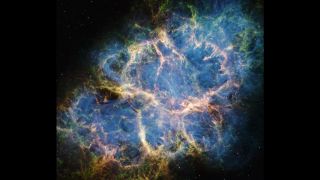In July 1504, astronomers in China documented a “guest star” in the sky that shone as brightly as Jupiter for nearly a month before gradually fading into invisibility.
That “star” was, in fact, a cloud of debris blown into space by a dying star roughly 6,500 light-years away in the constellation Taurus. In the 19th century, Irish astronomer Lord Rosse named the curious object the Crab Nebula, not least because it appeared to have “streams running out like claws in every direction.”
A new mosaic of the nebula by the mighty James Webb Space Telescope traces those “claws” in fresh, exquisite detail. For the first time, we are able to see the cage-like structures formed by countless dust grains, seen particularly prominently as fluffy magenta material in the upper right and lower left regions in Webb’s image of the nebula. Unlike other supernova remnants where dust dominates the central regions, much of the Crab’s dust reservoir is packed in filaments of the outer shell, astronomers say.

NASA’s James Webb Space Telescope dissected the Crab Nebula’s structure, aiding astronomers as they continue to evaluate leading theories about the supernova remnant’s origins. (Image credit: NASA, ESA, CSA, STScI, Tea Temim – Princeton University)
“The Crab Nebula lives up to a tradition in astronomy: The nearest, brightest, and best-studied objects tend to be bizarre,” study co-author Nathan Smith, of the Steward Observatory at the University of Arizona, said in a statement.
Ever since it exploded as a supernova, the star’s shell of material has been expanding at some 900 miles (1,500 kilometers) every second and now spans about 11 light-years across. The Crab Nebula is a well-studied object thanks to its cosmic closeness, yet despite decades of observations, the specifics of the explosion have remained elusive.
Related: The James Webb Space Telescope — A complete guide
Like most massive stars toward the end of their lives, the star at the heart of the Crab Nebula may have kickstarted its death when it began to churn out iron. Unlike other elements produced during nuclear fusion — the process that powers stars, which fusing hydrogen into heavier elements — iron demands more energy than it releases, meaning the star ended up succumbing to its own gravity and collapsing onto itself.
Breaking space news, the latest updates on rocket launches, skywatching events and more!
The Crab’s heart is now reigned by a rapidly spinning pulsar, seen in Webb’s image as the bright white dot in the center, with the magnetic field lines emerging from it seen as thin blue ribbons wisping in a ripple-like pattern.
A paper describing these findings has been accepted for publication in The Astrophysical Journal Letters.
Join our Space Forums to keep talking space on the latest missions, night sky and more! And if you have a news tip, correction or comment, let us know at: [email protected].
Sharmila Kuthunur is a Seattle-based science journalist covering astronomy, astrophysics and space exploration. Follow her on X @skuthunur.
>>> Read full article>>>
Copyright for syndicated content belongs to the linked Source : Space.com – https://www.space.com/crab-nebula-james-webb-space-telescope-video-photo





























